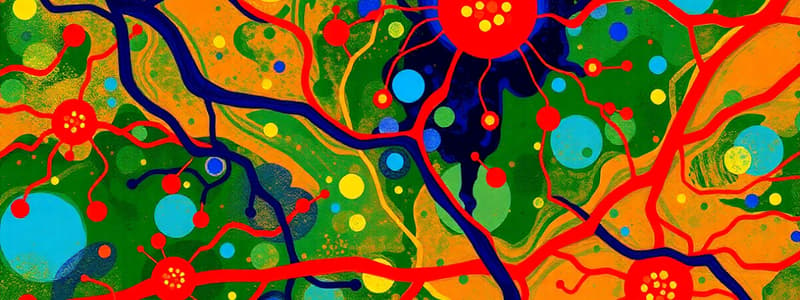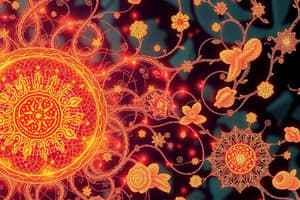Podcast
Questions and Answers
What is the primary function of signal transduction in cells?
What is the primary function of signal transduction in cells?
- To inhibit cell communication.
- To convert extracellular signals into cellular responses. (correct)
- To isolate cells from external stimuli.
- To convert cellular responses into extracellular signals.
Which class of receptors is characterized by their signaling mechanisms involving activation of G-Proteins?
Which class of receptors is characterized by their signaling mechanisms involving activation of G-Proteins?
- G-Protein Coupled Receptors (correct)
- Ubiquitin-Linked Receptors
- Adjacent Cell Bind Receptors
- Receptor Tyrosine Kinases
Which term describes the process of enhancing the strength of a cellular signal?
Which term describes the process of enhancing the strength of a cellular signal?
- Signal termination
- Signal transduction
- Signal inhibition
- Signal amplification (correct)
What role do second messengers play in signal transduction?
What role do second messengers play in signal transduction?
What is a common consequence of alterations in signal transduction pathways?
What is a common consequence of alterations in signal transduction pathways?
Which component is typically involved in the activation of receptor tyrosine kinases?
Which component is typically involved in the activation of receptor tyrosine kinases?
Which concept is NOT generally associated with G-Protein coupled receptors?
Which concept is NOT generally associated with G-Protein coupled receptors?
What is the role of adapter proteins in signal transduction?
What is the role of adapter proteins in signal transduction?
What is the primary function of a ligand when binding to a receptor protein?
What is the primary function of a ligand when binding to a receptor protein?
How is ligand specificity determined?
How is ligand specificity determined?
What does the dissociation constant (Kd) indicate?
What does the dissociation constant (Kd) indicate?
Which is a feature of second messengers in intracellular signaling?
Which is a feature of second messengers in intracellular signaling?
What is the role of GTPase switch proteins in cell signaling?
What is the role of GTPase switch proteins in cell signaling?
Which of the following describes the general response of a cell to a particular ligand?
Which of the following describes the general response of a cell to a particular ligand?
What is a characteristic of effectors in signaling pathways involving second messengers?
What is a characteristic of effectors in signaling pathways involving second messengers?
What happens to the ligand and receptor in target cells after they interact?
What happens to the ligand and receptor in target cells after they interact?
What is the primary role of trimeric G proteins in GPCR signaling pathways?
What is the primary role of trimeric G proteins in GPCR signaling pathways?
Which subunit of the trimeric G protein is primarily involved in switching between active and inactive forms?
Which subunit of the trimeric G protein is primarily involved in switching between active and inactive forms?
Which structure of the GPCR is essential for binding ligands?
Which structure of the GPCR is essential for binding ligands?
Which effector protein is commonly activated by GPCRs to enhance cAMP synthesis?
Which effector protein is commonly activated by GPCRs to enhance cAMP synthesis?
What action do hormone-occupied receptors perform in relation to Ga proteins?
What action do hormone-occupied receptors perform in relation to Ga proteins?
What is the function of cAMP phosphodiesterase in GPCR signaling?
What is the function of cAMP phosphodiesterase in GPCR signaling?
Which of the following statements about GPCRs is true?
Which of the following statements about GPCRs is true?
What is a characteristic of feedback regulation in GPCR signaling pathways?
What is a characteristic of feedback regulation in GPCR signaling pathways?
What is the primary result of the intrinsic GTPase activity of Gas?
What is the primary result of the intrinsic GTPase activity of Gas?
What role does cAMP phosphodiesterase play in cellular response?
What role does cAMP phosphodiesterase play in cellular response?
What is required for continued activation of adenylate cyclase?
What is required for continued activation of adenylate cyclase?
What effect do anchoring proteins have on cAMP?
What effect do anchoring proteins have on cAMP?
Which protein phosphorylates GPCR receptors leading to receptor endocytosis?
Which protein phosphorylates GPCR receptors leading to receptor endocytosis?
What does phosphorylated CREB do in signal transduction?
What does phosphorylated CREB do in signal transduction?
What is the role of b-arrestin in the receptor desensitization process?
What is the role of b-arrestin in the receptor desensitization process?
What kinases can be activated by the GPCR-arrestin complex?
What kinases can be activated by the GPCR-arrestin complex?
What happens to the Notch extracellular domain once it is released?
What happens to the Notch extracellular domain once it is released?
Which subunit of the g-secretase complex binds to the Notch stump generated by ADAM 10?
Which subunit of the g-secretase complex binds to the Notch stump generated by ADAM 10?
What is the role of Notch's cytoplasmic segment after being released?
What is the role of Notch's cytoplasmic segment after being released?
How do the Wnt and Hedgehog signaling pathways primarily get activated?
How do the Wnt and Hedgehog signaling pathways primarily get activated?
Which of the following accurately describes the role of GSK3 in signaling pathways?
Which of the following accurately describes the role of GSK3 in signaling pathways?
What happens to transcription factors in the resting state within the Wnt and Hedgehog pathways?
What happens to transcription factors in the resting state within the Wnt and Hedgehog pathways?
What receptor does Wnt primarily signal through?
What receptor does Wnt primarily signal through?
What consequence can activating mutations in Wnt and Hedgehog pathways have?
What consequence can activating mutations in Wnt and Hedgehog pathways have?
What is the role of ubiquitin ligase (E3 TrCP) in relation to b-catenin?
What is the role of ubiquitin ligase (E3 TrCP) in relation to b-catenin?
What event occurs when Wnt binds to Frizzled (Fz) and LRP?
What event occurs when Wnt binds to Frizzled (Fz) and LRP?
How does Hedgehog (Hh) influence Cubitis interruptus (Ci) transcription factor?
How does Hedgehog (Hh) influence Cubitis interruptus (Ci) transcription factor?
What post-translational modifications occur on the N-terminal fragment of Hedgehog?
What post-translational modifications occur on the N-terminal fragment of Hedgehog?
What happens to Patched and Smoothened upon Hedgehog binding to Patched?
What happens to Patched and Smoothened upon Hedgehog binding to Patched?
In the absence of Hedgehog, what is the role of Patched (Ptc)?
In the absence of Hedgehog, what is the role of Patched (Ptc)?
What is the role of the complex involving Fused (Fu), Costal-2 (Cos2), and Ci?
What is the role of the complex involving Fused (Fu), Costal-2 (Cos2), and Ci?
What common feature distinguishes Hedgehog signaling from Wnt signaling?
What common feature distinguishes Hedgehog signaling from Wnt signaling?
Flashcards
Signal Transduction
Signal Transduction
The process of converting extracellular signals into cellular responses.
Signal transduction pathway
Signal transduction pathway
A series of steps that converts a signal from outside the cell to a specific cellular response.
receptor-ligand interaction
receptor-ligand interaction
The specific binding of a signaling molecule (ligand) to a receptor protein on the cell surface or within the cell.
G-protein coupled receptor (GPCR)
G-protein coupled receptor (GPCR)
Signup and view all the flashcards
receptor tyrosine kinases (RTK)
receptor tyrosine kinases (RTK)
Signup and view all the flashcards
second messenger
second messenger
Signup and view all the flashcards
protein kinase
protein kinase
Signup and view all the flashcards
protein phosphatase
protein phosphatase
Signup and view all the flashcards
cellular responses
cellular responses
Signup and view all the flashcards
signal amplification
signal amplification
Signup and view all the flashcards
Receptor Proteins
Receptor Proteins
Signup and view all the flashcards
Ligand Specificity
Ligand Specificity
Signup and view all the flashcards
Effector Specificity
Effector Specificity
Signup and view all the flashcards
Ligand Affinity (Kd)
Ligand Affinity (Kd)
Signup and view all the flashcards
Second Messengers
Second Messengers
Signup and view all the flashcards
Signal Amplification
Signal Amplification
Signup and view all the flashcards
GTPase Switch Proteins
GTPase Switch Proteins
Signup and view all the flashcards
Intracellular Signal Transduction
Intracellular Signal Transduction
Signup and view all the flashcards
G protein-coupled receptor (GPCR)
G protein-coupled receptor (GPCR)
Signup and view all the flashcards
Trimeric G protein
Trimeric G protein
Signup and view all the flashcards
Gα subunit
Gα subunit
Signup and view all the flashcards
Effector protein
Effector protein
Signup and view all the flashcards
cAMP (cyclic AMP)
cAMP (cyclic AMP)
Signup and view all the flashcards
Adenyl cyclase
Adenyl cyclase
Signup and view all the flashcards
Second messenger
Second messenger
Signup and view all the flashcards
Gas protein inactivation
Gas protein inactivation
Signup and view all the flashcards
Adenylate cyclase as GAP
Adenylate cyclase as GAP
Signup and view all the flashcards
cAMP phosphodiesterase activity
cAMP phosphodiesterase activity
Signup and view all the flashcards
Receptor desensitization
Receptor desensitization
Signup and view all the flashcards
BARK phosphorylation
BARK phosphorylation
Signup and view all the flashcards
b-arrestin role
b-arrestin role
Signup and view all the flashcards
CREB phosphorylation
CREB phosphorylation
Signup and view all the flashcards
Gene transcription activation
Gene transcription activation
Signup and view all the flashcards
GPCR-arrestin kinase activation
GPCR-arrestin kinase activation
Signup and view all the flashcards
Anchoring proteins
Anchoring proteins
Signup and view all the flashcards
Notch signaling
Notch signaling
Signup and view all the flashcards
Delta protein
Delta protein
Signup and view all the flashcards
G-secretase
G-secretase
Signup and view all the flashcards
Ubiquitination
Ubiquitination
Signup and view all the flashcards
Wnt pathway
Wnt pathway
Signup and view all the flashcards
b-catenin
b-catenin
Signup and view all the flashcards
Frizzled Receptor
Frizzled Receptor
Signup and view all the flashcards
Wnt signaling range
Wnt signaling range
Signup and view all the flashcards
Wnt signaling pathway
Wnt signaling pathway
Signup and view all the flashcards
b-catenin degradation
b-catenin degradation
Signup and view all the flashcards
Wnt binding to LRP
Wnt binding to LRP
Signup and view all the flashcards
b-catenin stabilization
b-catenin stabilization
Signup and view all the flashcards
b-catenin nuclear translocation
b-catenin nuclear translocation
Signup and view all the flashcards
Hedgehog signal in Drosophila
Hedgehog signal in Drosophila
Signup and view all the flashcards
Hedgehog protein processing
Hedgehog protein processing
Signup and view all the flashcards
Hedgehog modification
Hedgehog modification
Signup and view all the flashcards
Hedgehog Signaling - Ptc and Smo
Hedgehog Signaling - Ptc and Smo
Signup and view all the flashcards
Ci Transcription Factor Activation
Ci Transcription Factor Activation
Signup and view all the flashcards
Study Notes
Cell Signaling - Signal Transduction
- Signal transduction converts extracellular signals into cellular responses
- Extracellular signaling regulates interactions between unicellular and multicellular organisms
- Cells communicate, and no cell lives in isolation
- Signal transduction pathways are conserved
- Signal transduction involves steps from extracellular signals to cellular responses
- Signal transduction can be hydrophilic or hydrophobic
- Hydrophilic signaling molecules cannot diffuse across the membrane, binding to cell-surface receptors.
- Example hydrophilic molecules include peptides, etc.
- Example hydrophobic molecules include steroids, etc.
- Signal transduction includes intracellular signal transduction pathways
- Different signaling molecules can activate intracellular signaling pathways or use intracellular signaling components differently
- Receptors and signaling molecules bind in specific ways
- Maximal response of a cell depends on the ligand concentration
- Receptors activate a limited number of signaling pathways
- Cells modify or degrade signals to terminate a response
- Signaling molecules operate at various distances
- Signaling by membrane attached signals or juxtaposed cells is called juxtaposed signaling
- Intracellular signal transduction includes second messengers, conserved proteins (GTPase switch proteins, kinases, phosphatases), resetting or termination of the signal, and regulation/interaction of signaling pathways
- Second messengers are intracellular signaling molecules that carry signals from receptors.
- Examples of second messengers include cAMP, cGMP, DAG, IP3.
- The concentration of second messengers is modulated by binding of ligands to cell surface receptors
- Second messengers regulate activities of enzymes and nonenzymatic proteins
- GTPase switch proteins are conserved GTP-binding proteins that act as on-off molecular switches
- Protein kinases phosphorylate Ser or Thr residues to activate or inactivate the protein
- Protein phosphatases remove phosphate residues to activate or inactivate the targets
- Adapter proteins coordinate the formation of multicomponent signaling complexes
- Multiple signaling pathways can integrate responses in different tissues
- Receptors are on cell surfaces or intracellularly based on ligand type
- Ligand specificity is determined by the noncovalent protein interactions
- Ligand binding often changes the receptors' properties
- Receptors can activate a limited number of signaling pathways in target cells
- Receptor desensitization occurs at high ligand concentrations
G Protein-Coupled Signal Transduction Pathway
- Trimeric G proteins transduce signals from cell-surface receptor to effector proteins
- G proteins have a receptor that contains seven transmembrane domains
- G proteins can be further divided into classes based on how they bind ligands
Receptor Tyrosine Kinase Pathways
- Receptor tyrosine kinases (RTKs), recognize soluble or membrane-bound peptide/protein hormones as growth factors
- Binding of a ligand to RTKs stimulates tyrosine kinase activity, initiating cascades that result in gene expression in target cells
- RTK pathways are important for cell proliferation, differentiation, survival, and cellular metabolism
Notch/Delta Signaling Pathway
- Extracellular signaling molecules are on juxtaposed cells
- Notch receptors on a cell bind to a Delta protein on a neighboring cell
- This results in two proteolytic cleavages in the Notch receptor
- Released Notch cytoplasmic segment acts as transcription factor in the nucleus to modulate transcription
Signaling Controlled by Ubiquitination
- Ubiquitination and proteolysis of proteins are important in signal transduction pathways, such as Wnt and Hedgehog.
- Target proteins can be transcription factors or transcription factor inhibitors.
- Various proteins and signaling pathways can contribute to development and diseases.
- Signal transduction pathways are involved in important events, such as neural tube closure, limb development, heart development, and other critical developmental events.
NF-κB Pathway
- NF-κB is a transcription factor crucial for cellular response to infection and inflammation.
- The degradation of IκBα protein activates NF-κB to initiate transcription of target genes in the nucleus
- NF-κB pathway involves several steps, including ligand binding, receptor activation, IκB kinase (IKK) phosphorylation/activation, ubiquitination and degradation of IκBa, translocation of NF-κB to the nucleus, and finally transcription of target genes within the nucleus
Studying That Suits You
Use AI to generate personalized quizzes and flashcards to suit your learning preferences.




